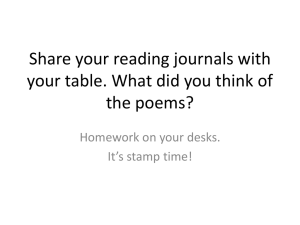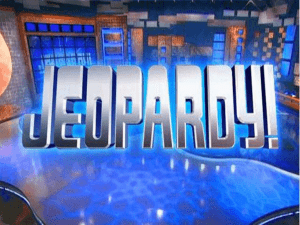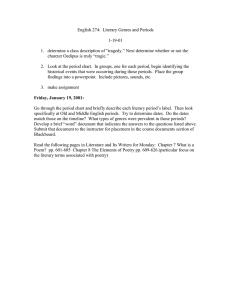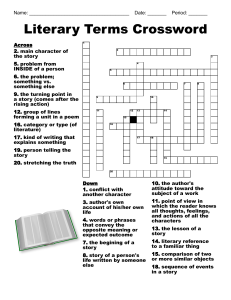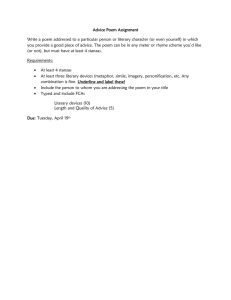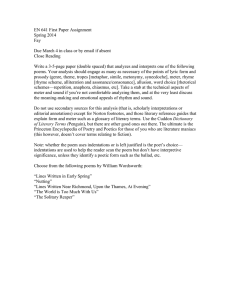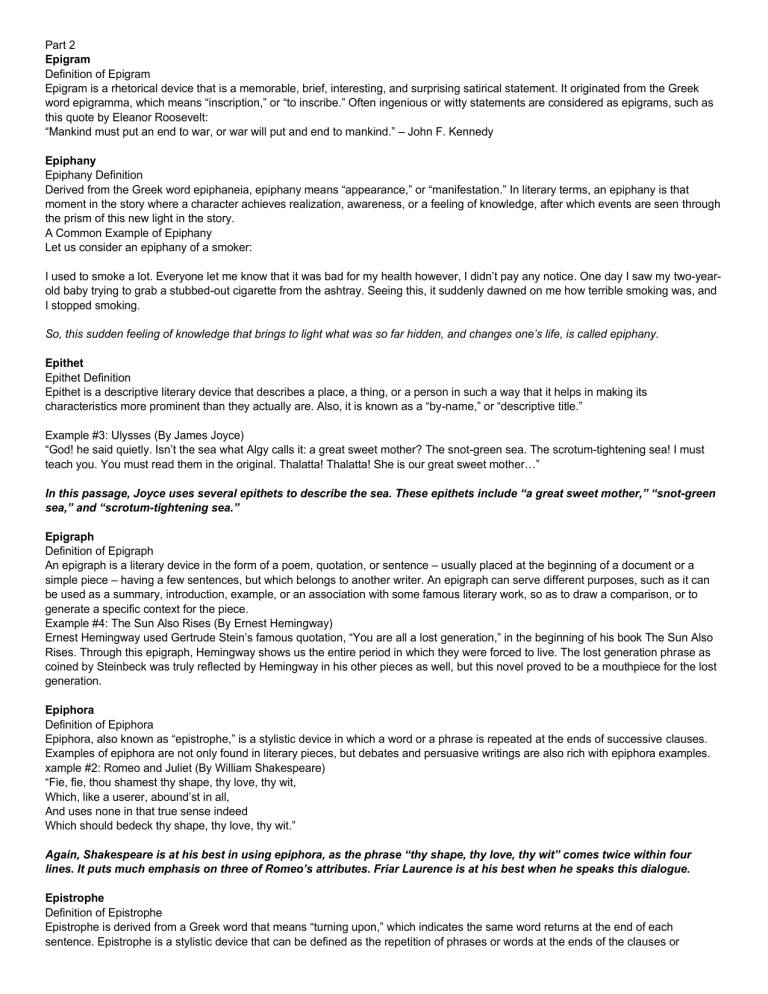
Part 2 Epigram Definition of Epigram Epigram is a rhetorical device that is a memorable, brief, interesting, and surprising satirical statement. It originated from the Greek word epigramma, which means “inscription,” or “to inscribe.” Often ingenious or witty statements are considered as epigrams, such as this quote by Eleanor Roosevelt: “Mankind must put an end to war, or war will put and end to mankind.” – John F. Kennedy Epiphany Epiphany Definition Derived from the Greek word epiphaneia, epiphany means “appearance,” or “manifestation.” In literary terms, an epiphany is that moment in the story where a character achieves realization, awareness, or a feeling of knowledge, after which events are seen through the prism of this new light in the story. A Common Example of Epiphany Let us consider an epiphany of a smoker: I used to smoke a lot. Everyone let me know that it was bad for my health however, I didn’t pay any notice. One day I saw my two-yearold baby trying to grab a stubbed-out cigarette from the ashtray. Seeing this, it suddenly dawned on me how terrible smoking was, and I stopped smoking. So, this sudden feeling of knowledge that brings to light what was so far hidden, and changes one’s life, is called epiphany. Epithet Epithet Definition Epithet is a descriptive literary device that describes a place, a thing, or a person in such a way that it helps in making its characteristics more prominent than they actually are. Also, it is known as a “by-name,” or “descriptive title.” Example #3: Ulysses (By James Joyce) “God! he said quietly. Isn’t the sea what Algy calls it: a great sweet mother? The snot-green sea. The scrotum-tightening sea! I must teach you. You must read them in the original. Thalatta! Thalatta! She is our great sweet mother…” In this passage, Joyce uses several epithets to describe the sea. These epithets include “a great sweet mother,” “snot-green sea,” and “scrotum-tightening sea.” Epigraph Definition of Epigraph An epigraph is a literary device in the form of a poem, quotation, or sentence – usually placed at the beginning of a document or a simple piece – having a few sentences, but which belongs to another writer. An epigraph can serve different purposes, such as it can be used as a summary, introduction, example, or an association with some famous literary work, so as to draw a comparison, or to generate a specific context for the piece. Example #4: The Sun Also Rises (By Ernest Hemingway) Ernest Hemingway used Gertrude Stein’s famous quotation, “You are all a lost generation,” in the beginning of his book The Sun Also Rises. Through this epigraph, Hemingway shows us the entire period in which they were forced to live. The lost generation phrase as coined by Steinbeck was truly reflected by Hemingway in his other pieces as well, but this novel proved to be a mouthpiece for the lost generation. Epiphora Definition of Epiphora Epiphora, also known as “epistrophe,” is a stylistic device in which a word or a phrase is repeated at the ends of successive clauses. Examples of epiphora are not only found in literary pieces, but debates and persuasive writings are also rich with epiphora examples. xample #2: Romeo and Juliet (By William Shakespeare) “Fie, fie, thou shamest thy shape, thy love, thy wit, Which, like a userer, abound’st in all, And uses none in that true sense indeed Which should bedeck thy shape, thy love, thy wit.” Again, Shakespeare is at his best in using epiphora, as the phrase “thy shape, thy love, thy wit” comes twice within four lines. It puts much emphasis on three of Romeo’s attributes. Friar Laurence is at his best when he speaks this dialogue. Epistrophe Definition of Epistrophe Epistrophe is derived from a Greek word that means “turning upon,” which indicates the same word returns at the end of each sentence. Epistrophe is a stylistic device that can be defined as the repetition of phrases or words at the ends of the clauses or sentences. It is also called “epiphora.” Epistrophe examples are frequently found in literary pieces, in persuasive writing, and in speeches. The Difference Between Anaphora and Epistrophe Anaphora is the opposite of epistrophe, and means the repetition of the same phrase or word at the beginning of successive sentences, such as in this example: Five years have passed; Five summers, with the length of Five long winters! and again I hear these waters … However, in epistrophe, the repetition of phrases or words is at the end of successive sentences such as in this example: “Hourly joys be still upon you! Juno sings her blessings on you … Scarcity and want shall shun you, Ceres’ blessing so is on you.” Enjambment Definition of Enjambment Enjambment is a literary device in which a line of poetry carries its idea or thought over to the next line without a grammatical pause. With enjambment, the end of a poetic phrase extends past the end of the poetic line. This means that the thought or idea “steps over” the end of a line in a poem and into the beginning of the next line. The absence of punctuation allows for enjambment, and requires the reader to read through a poem’s line break without pausing in order to understand the conclusion of the thought or idea. Enjambment is often used by poets as a means of minimizing the difference between the sound of verse and the sound of prose, creating a poem that flows freely and emphasizes unexpected beats and words for the reader. For example, T.S. Eliot utilizes enjambment as a literary device in his poem “The Waste Land”: April is the cruelest month, breeding Lilacs out of the dead land, mixing Memory and desire, stirring Dull roots with spring rain. With Eliot’s use of enjambment, the action words are deliberately placed at the end of each line. Therefore, the reader must take a slight pause at the enjambed poetic line, even though the thought continues. This emphasizes the verbs in the poem and underscores the upheaval and reproduction experienced by nature in April. Epilogue Epilogue Definition An epilogue, or “epilog,” is a chapter at the end of a work of literature, which concludes the work. Epistle Epistle Definition An epistle is a letter in the form of prose or poetry to a particular person or group. It can also be a story or a religious sermon similar to the New Testament letters written by Paul, Peter, and John to their church congregation or a small group of believers. Traditionally, an epistle was written to express love, philosophy, religion, and morality. However, the roots of epistle composition date back to ancient Roman poetic form and The Bible. Most of the epistles are written in free verse without following any strict meter or rhyme. In this sense, the writers are free to write in whatever narration, or character they select to write. Etymologically, epistle refers to a letter or written communication. Types of Epistle In literature, there are two basic traditions of verse epistles. Horace’s Epistles: The tradition of Horace’s epistle deals with moral and philosophical themes and has been the most popular form since the Renaissance. Ovid’s Epistle: The tradition based on Ovid’s epistle includes romanticism and other sentimental subjects. These epistles gained popularity in Europe during the Middle Ages. The best example of Ovid’s epistle is the letter of Paul the Apostle that illustrates the spread of Christianity in the world. Epitaph Definition of Epitaph When somebody from our family, or a friend dies, we want to commemorate his or her memory. For this, we use an epitaph, which is a brief writing or saying inscribed on a grave. Generally, it is a brief composition, having figurative sense in a verse or in prose form, written to pay tribute to a deceased person, or to remember a past event. Strictly speaking, an epitaph is a short text on a plaque or tombstone, honoring a dead person. It is derived from the Greek word epitaphios, which means “funeral oration.” Many poets and authors, such as William Shakespeare, Sylvia Plath, Oscar Wilde, and John Keats have written their own epitaphs prior to their deaths. Euphony The literary device euphony is derived from the Greek word euphonos, which means “sweet-voiced.” It can be defined as the use of words and phrases that are distinguished as having a wide range of noteworthy melody or loveliness in the sounds they create. It gives pleasing and soothing effects to the ear due to repeated vowels and smooth consonants. It can be used with other literary devices like alliteration, assonance and rhyme to create more melodic effects. Examples of euphony are commonly found in poetry and literary prose. External Conflict External conflict is a struggle that takes place between the main character and some outside force. Therefore, it is outside the body of the protagonist. Usually, it occurs when the protagonist struggles against the antagonist, a character that opposes the protagonist in the main body of the story. Other types of external conflict could also arise due to some other factors such as the forces of nature, and society in which the protagonist lives. Types of External Conflict There are different types of external conflict found in stories. The most common are: Character vs. Character This type of conflict occurs when a character struggles against other characters in the story, for instance in the Harry Potter series. Harry engages in a battle against Lord Voldemort. Character vs. Society This external conflict occurs when the main character stands up to support his beliefs and struggles against the social forces, for instance Sophocles’ “Antigone.” Character vs. Nature In this type of external conflict, the protagonist struggles against the forces of nature, or an external environment. For instance, in the short story To Build a Fire, Jack London tells a story of an anonymous narrator and his dog, traveling through the wilderness of Yukon Trail. Examples of Feminine Rhyme from Literature Example #1 Desire by Philip Sydney “But yet in vain thou hast my ruin sought, In vain thou mad’st me to vain things aspire, In vain thou kindlist all thy smoky fire. For virtue hath this better lesson taught, Within myself to seek my only hire, Desiring naught but how to kill desire.” The above stanza is the second part or sestet of Sydney’s sonnet “Desire.” Although the subject matter of the poem and the overall thematic strand is quite different from its rhyming pattern, sestet shows the use of feminine rhyme. All the final syllables of the last words of the lines are unstressed or unaccented. This is one of the best examples of a feminine rhyme. Just note the pattern of the rhyme scheme where “fire and aspire,” “sought and taught,” and “hire and desire” rhyme in such a way that the final unstressed syllable rhyme with the following words which are written in the same pattern. Foot The literary device “foot” is a measuring unit in poetry, which is made up of stressed and unstressed syllables. The stressed syllable is generally indicated by a vertical line ( | ), whereas the unstressed syllable is represented by a cross ( X ). The combination of feet creates meter in poetry. Later, these meters are joined for the composition of a complete poem. Therefore, a foot is the formative unit of the meter. In poetry, there are various types of foot, each of which sounds differently. Some of the basic types of foot are given below: Iamb: Combination of unstressed and stressed syllable – (daDUM) Trochee: Combination of stressed and unstressed syllables – (DUMda) Spondee: Combination of two stressed syllables – (DUMDUM) Anapest: Combination of two unstressed and a stressed syllable – (dadaDUM) Dactyl: Combination of stressed and two unstressed syllables – (DUMdada) Amphibrach: Combination of unstressed, stressed and unstressed syllable – (daDUMda) Pyrrhic: Combination of two unstressed syllables – (dada) Free Verse Free verse is a literary device that can be defined as poetry that is free from limitations of regular meter or rhythm, and does not rhyme with fixed forms. Such poems are without rhythm and rhyme schemes, do not follow regular rhyme scheme rules, yet still provide artistic expression. In this way, the poet can give his own shape to a poem however he or she desires. However, it still allows poets to use alliteration, rhyme, cadences, and rhythms to get the effects that they consider are suitable for the piece. Foil Definition of Foil Foil is a literary device designed to illustrate or reveal information, traits, values, or motivations of one character through the comparison and contrast of another character. A literary foil character serves the purpose of drawing attention to the qualities of another character, frequently the protagonist. This is effective as a means of developing a deeper understanding of a character by emphasizing their strengths and weaknesses. In addition, a literary foil allows writers to create a counterpart for the protagonist that puts their actions and choices in context. Genre Definition of Genre Genre originates from the French word meaning kind or type. As a literary device, genre refers to a form, class, or type of literary work. The primary genres in literature are poetry, drama/play, essay, short story, and novel. The term genre is used quite often to denote literary sub-classifications or specific types of literature such as comedy, tragedy, epic poetry, thriller, science fiction, romance, etc. Hypophora Definition of Hypophora Hypophora is a figure of speech in which a writer raises a question, and then immediately provides an answer to that question. Commonly, a question is asked in the first paragraph, and then the paragraph is used to answer the question. It is also known as “antipophora,” or “anthypophora.” At first look, examples of hypophora may seem similar to rhetorical question examples, but there is a slight difference as explained below. Hubris Hubris is character trait that features excessive pride or inflated self-confidence, leading a protagonist to disregard a divine warning or violate an important moral law. As a literary device, hubris is commonly exhibited by a tragic hero as their tragic flaw, or hamartia. The extreme pride or arrogance of hubris often consumes a character, blinding them to reason and resulting in their ultimate downfall. In Medias Res In Medias Res Definition In Medias Res means narrating a story from the middle after supposing that the audiences are aware of past events. The etymology of this literary device goes back to the Roman lyric poet, Horace, who used it in his poem Ars Poetica as “Semper ad eventum festinat et in medias res….” It is a Latin phrase which literally denotes “in the midst of things.” Hence, the author employs this expression as a common strategy to initiate their stories. In medias res demands beginning a narrative in the very middle of its action from some vital point when most of the action has occurred. The author then freely moves backward and forward at his leisure, connecting the dots of the story. All the explanations regarding the significance of setting, plot, characters and the minutiae of the story are gradually revealed in the form of a character’s dialogues or thoughts, or flashbacks. The setting and environment also contribute to add to the details of the action introduced at the beginning of the story. Example #1 Iliad by Homer Intertextuality Definition of Intertextuality Intertextuality is a sophisticated literary device making use of a textual reference within some body of text, which reflects again the text used as a reference. Instead of employing referential phrases from different literary works, intertextuality draws upon the concept, rhetoric, or ideology from other writings to be merged in the new text. It may be the retelling of an old story, or the rewriting of popular stories in modern context for instance, James Joyce retells The Odyssey in his very famous novel Ulysses. Idiom Definition of Idiom The term idiom refers to a set expression or a phrase comprising two or more words. An interesting fact regarding the device is that the expression is not interpreted literally. The phrase is understood to mean something quite different from what individual words of the phrase would imply. Alternatively, it can be said that the phrase is interpreted in a figurative sense. Further, idioms vary in different cultures and countries. Inciting Incident Definition of Inciting Incident Inciting incident in a plot is an event or a point that arrives at the beginning of a play, story book, or a film that disturbs the actions and life of a protagonist, and sets him to pursue the mission vigorously. It originates from a Latin word, incitāre, which means to start up, to put something into rapid motion, or to stimulate, or encourage something or some character. Juxtaposition Definition of Juxtaposition Juxtaposition is a literary device that implies comparison or contrast. Writers create juxtaposition by placing two entities side by side to create dramatic or ironic contrast. Juxtaposition is a form of implied comparison in that there is no overt comparison or inference on the part of the writer. This allows the reader to discern how the paired entities are similar or different. The effect of this literary device is a more profound understanding of contrast and creating a sense of fate or inevitability in the comparison. Famous Examples of Juxtaposition in Novels and Stories Many novels and stories are well-known due to their juxtaposition of ideas, settings, characters, and themes. Here are some famous examples of juxtaposition in familiar novels and stories: East Egg and West Egg in The Great Gatsby Individual thought and groupthink in 1984 wealth and poverty in The Prince and the Pauper land and sea in Moby Dick human and animal instinct in Life of Pi kindness and selfishness in Cinderella Lennie (innocent) and George (jaded) in Of Mice and Men Muggle and wizard worlds in Harry Potter Series frontier and civilization in The Adventures of Huckleberry Finn freedom and confinement in To Kill a Mockingbird Lampoon Lampoon is a form of virulent satire in verse or prose, which is sometimes a malicious or unjust attack on a person, an institute, or an activity. Simply, when a writer or an artist makes fun of someone or something, by imitating the same thing in a funny way, it is called “lampooning.” Example of Lampoon in Music Example #1: Money (by Pink Floyd) “Money, get away. Get a good job with good pay and you’re okay. Money, it’s a gas. Money, so they say Is the root of all evil today. But if you ask for a raise it’s no surprise that they’re giving none away …” Pink Floyd has elaborated lampoon satirical musical album “The Dark Side of the Moon” with political and social commentary. In this song, the satire of greed for money is emphasized. Money is sardonic and biting, there reason that there is no way to think about other things. Limerick A limerick is a poem that consists of five lines in a single stanza with a rhyme scheme of AABBA. Most limericks are intended to be humorous, and many are considered bawdy, suggestive, or downright indecent. The subject of limericks is generally trivial or silly in nature. Most limericks are considered “amateur” poetry due to their short length and relatively simplistic structure. However, this does not take away from reader enjoyment of this literary device. Perhaps the most famous example of limerick begins with the line: There once was a man from Nantucket. There are numerous limerick variations that begin this way, many of which are considered “dirty” or inappropriate. However, here is an example of an appropriate version from 1902 by Dayton Voorhees: There once was a man from Nantucket Who kept all his cash in a bucket. But his daughter, named Nan, Ran away with a man And as for the bucket, Nantucket. Meter Meter is a literary device that works as a structural element in poetry. Essentially, meter is the basic rhythmic structure of a line within a poem or poetic work. Meter functions as a means of imposing a specific number of syllables and emphasis when it comes to a line of poetry that adds to its musicality. It consists of the number of syllables and the pattern of emphasis on those syllables. In addition, meter governs individual units within a line of poetry, called “feet.” A “foot” of a poetic work features a specific number of syllables and pattern of emphasis. Common Examples of Metrical Feet For English poetry, metrical feet generally feature two or three syllables. They are categorized by a specific combination of stressed and unstressed syllables. The most common examples of metrical feet include: Trochee: stressed syllable followed by unstressed syllable, as in “custom” Iamb: unstressed syllable followed by stressed syllable, as in “describe” Spondee: equal stress for both syllables, as in “cupcake” Dactyl: stressed syllable, followed by two unstressed syllables, as in “bicycle” Anapest: two unstressed syllables, followed by a stressed syllable, as in “understand” The repetition of metrical feet in a line of poetry creates poetic meter, like beats in music. The length of a poetic meter is labeled with Greek suffixes: one foot = monometer two feet = dimeter three feet = trimeter four feet = Iatetrameter five feet = pentameter six feet = hexameter seven feet = heptameter eight feet = octameter Maxim A literary device, maxim is a simple and memorable line, quote, or rule for taking action and leading a good life. Simply put, it is a thought with moralistic values that intends to motivate individuals. Maxim is, in fact, a type of saying, or a brief statement of a great thought about life, especially a sententious or aphoristic one such as, “He who hesitates is lost.” It helps in characterizing characters Memoir Memoir is a written factual account of somebody’s life. It comes from the French word mémoire, which means “memory,” or “reminiscence.” This literary technique tells a story about the experiences of someone’s life. A literary memoir is usually about a specific theme, or about a part of someone’s life. It is a story with a proper narrative shape, focus, and subject matter, involving reflection on some particular event or place. Examples of Memoir in Literature Example #1: A Moveable Feast (By Ernest Hemingway) Ernest Hemingway was an acclaimed celebrity during the times when the public treated American writers like movie stars. His memoir A Moveable Feast was published after his death in 1964. This memoir is a collection of stories about his time spent in Paris as a writer in 1920s, before attaining popularity. During these days, he was acquainted with many other famous writers, including Ezra Pound, F. Scott Fitzgerald, and Gertrude Stein. Motif Motif is an object or idea that repeats itself throughout a literary work. Motif and Theme In a literary work, a motif can be seen as an image, sound, action, or other figure that has a symbolic significance, and contributes toward the development of a theme. Motif and theme are linked in a literary work, but there is a difference between them. In a literary piece, a motif is a recurrent image, idea, or symbol that develops or explains a theme, while a theme is a central idea or message. Pastiche Pastiche is a literary piece that imitates a famous literary work by another writer. Unlike parody, its purpose is not to mock, but to honor the literary piece it imitates. Persona The term persona has been derived from the Latin word persona, which means “the mask of an actor,” and is therefore etymologically linked to the dramatis personae, which refers to the list of characters and cast in a play or a drama. It is also known as a “theatrical mask.” It can be defined in a literary work as a voice or an assumed role of a character, which represents the thoughts of a writer, or a specific person the writer wants to present as his mouthpiece. Poetic Justice Poetic Justice Definition In literature, poetic justice is an ideal form of justice, in which the good characters are rewarded and the bad characters are punished, by an ironic twist of fate. It is a strong literary view that all forms of literature must convey moral lessons. Therefore, writers employ poetic justice to conform to moral principles. Example #3: Oedipus Rex (By Sophocles) A classic example of poetic justice is found in the Greek tragedy Oedipus Rex, by Sophocles. In the play, Oedipus has committed the crime of defying gods by trying to escape his fate. Therefore, he left the kingdom he lived in, and went to the new kingdom of Thebes. He killed the king of the city after a quarrel, and married the queen. Later, we learn that the prophecy turned out true, as the man he killed turned out to be his father, and the queen his own mother. The Greek believed their destinies were predetermined – shaped by the gods and goddesses. Whosoever tried to defy them, committed a sin and deserved punishment. Function of Poetic Justice Generally, the purpose of poetic justice in literature is to adhere by the universal code of morality, in that virtue triumphs vice. The idea of justice in literary texts manifests the moral principle that virtue deserves a reward, and vices earn punishment. Palindrome The term palindrome is derived from two Greek words, palin, which means “again,” and dromos, which means “way,” or “direction.” It is defined as a number, a word, a sentence, a symbol, or even signs that can be read forward as well as backward, or in reverse order with the same effects and meanings. Example #1: The Funny Side of English (By O. A. Booty) “Lewd did I live & evil I did dwel.” This is the first sentence using a palindrome that appeared in the English language, back in 1614. In this sentence, the words read the same forward and backward. Prologue Prologue comes from the Greek term prologos, which means “before word,” is an opening of a story that establishes the setting, and gives background details. Prosody A literary technique, prosody is the study of meter, intonation, and rhythm of a poetic work. It is a phonetic term that uses meter, rhythm, tempo, pitch, and loudness in a speech for conveying information about the meanings and structure of an utterance. In addition, prosody is an important element of language that contributes toward rhythmic and acoustic effects in a piece of writing. It includes different elements, such as scansion, sound, pace, and meaning. Types of Prosody There are four distinguishable prosodic metrical patterns, which are: Syllabic Prosody – Syllabic prosody counts a fixed number of syllables in each line, while accent, tone, and quantity play a secondary role. Accentual Prosody – Accentual prosody measures only the accents or stresses in a line of verse, while the overall number of syllables may vary in a line. It is very common in Germanic, old English, and modern English verses. Accentual-syllabic Prosody – Accentual-syllabic prosody counts both the number of syllables and accents in each line. We commonly find it in English poetry. Quantitative Prosody – Quantitative prosody does not measure the number of syllables, rather depending upon duration of syllables. This can be determined by the amount of time used on pronunciation, such as a free-verse poem that consists of unmeasured lines. We find this type of prosody in Roman and classical Greek poetry, and only very rarely in English poetry. Play Play is a literary form of writing for theatre, which narrates a story with elements of conflicts, tensions, and actions through dialogues of characters. For dramatic significance, it is divided into acts and scenes. The writers present their feelings, emotions, and ideas through their characters and make them speak. Elements of Play A play has certain elements such as, Plot: It refers to the order of the events that occur in the play. Characters: The characters form a crucial part of the story and are interwoven with the plot of the play. Dialogue: It refers to the conversation or interactions between the characters in the play. Setting: It refers to the time and place where a story is set. It is one of the important parts of the play. Conflict: It refers to the challenge main characters need to solve to achieve their goals. Resolution: It is the unfolding or the solution to a complex issue in a story. Poem A poem is a collection of spoken or written words that expresses ideas or emotions in a powerfully vivid and imaginative style. A poem is comprised of a particular rhythmic and metrical pattern. In fact, it is a literary technique that is different from prose or ordinary speech, as it is either in metrical pattern or in free verse. Writers or poets express their emotions through this medium more easily, as they face difficulty when expressing through some other medium. It serves the purpose of a light to take the readers towards the right path. Also, sometimes it teaches them a moral lesson through sugar-coated language. Types of Poem Haiku – A type of Japanese poem consisting of three unrhymed lines, with mostly five, seven, and five syllables in each line. Free Verse – Consists of non–rhyming lines, without any metrical pattern, but which follow a natural rhythm. Epic – A form of lengthy poem, often written in blank verse, in which poet shows a protagonist in action of historical significance, or a great mythic. Ballad – A type of narrative poem in which a story often talks about folk or legendary tales. It may take the form of a moral lesson or a song. Sonnet – It is a form of lyrical poem containing fourteen lines, with iambic pentameter and tone or mood changes after the eighth line. Elegy – A melancholic poem in which the poet laments the death of a subject, though he gives consolation towards the end. Epitaph – A small poem used as an inscription on a tombstone. Hymn – This type of a poem praises spirituality or God’s splendor. Limerick – This is a type of humorous poem with five anapestic lines in which the first, second, and fifth lines have three feet, and the third and fourth lines have two feet, with a strict rhyme scheme of aabba. Villanelle – A French styled poem with nineteen lines, composed of three–line stanza, with five tercets and a final quatrain. It uses refrain at the first and third lines of each stanza. Rhetorical Devices Rhetorical devices are literary elements used to convince or persuade audiences using logos, pathos, and ethos. Their appropriate use makes the text rich, lifelike and enjoyable in prose and poetry. When carefully inserted, they transform an ordinary piece of writing into a memorable, evocative and pleasant literary work. It is due to these devices the readers feel aligned to the character or the writer. Also, the audiences understand the uniqueness and depth of the text. However, rhetorical devices appeal to one’s sensibilities in four ways: logos, pathos, ethos, and kairos. Examples Alliteration, Antithesis, Anaphora, Refrain, Metaphor, Parallelism Rhyme Rhyme is a literary device, featured particularly in poetry, in which identical or similar concluding syllables in different words are repeated. Rhyme most often occurs at the ends of poetic lines. In addition, rhyme is principally a function of sound rather than spelling. For example, words rhyme that end with the same vowel sound but have different spellings: day, prey, weigh, bouquet. This is true for words with the same consonant ending as well: vain, rein, lane. Rhyme is therefore predominantly independent of the way words look or are spelled. Writers use rhymes as a way to create sound patterns in order to emphasize certain words and their relationships with others in an artistic manner. Common Examples of Rhyme Forms There are many types of rhyme, particularly in poetry. Here are some common examples of rhyme forms: Perfect Rhyme: This rhyme form features two words that share the exact assonance and number of syllables, and is also known as a true rhyme. (skylight and twilight) Slant Rhymes: This rhyme form features words with similar but not exact assonance and/or number of syllables. This is also known as half rhyme or imperfect rhyme. (grieve and believe) Eye Rhymes: This rhyme form features two words that appear similar when read, but do not actually rhyme when spoken or pronounced. (Mood and hood; move and dove) Masculine Rhyme: This rhyming form takes place between the final stressed syllables of two lines. (compare and repair) Feminine Rhyme: This rhyming form features multi-syllables in which stressed and unstressed syllables rhyme with each other, respectively. (lazy and crazy) End Rhymes: These are rhymes that occur between the final words of two consecutive lines of poetry or non-consecutive lines following rhyme scheme in a stanza. Sarcasm Definition of Sarcasm Sarcasm generally takes the form of an ironic remark, somewhat rooted in humor, that is intended to mock or satirize something. When a speaker is being sarcastic, they are saying something different than what they actually mean. As a literary device, sarcasm can convey a writer and/or character’s true feelings of frustration, anger, and even derision, though veiled by the presence of humor and wording that is inconsistent with what is intended. However, since sarcastic statements, as they are worded, contradict the speaker’s intent and true meaning, it can be difficult for writers to effectively utilize this literary device without proper context or tone. Zombies eat brains. You’re safe. Ugliness can be fixed, stupidity is forever. You are depriving some village of their idiot. Did somebody write “stupid” on my forehead? I’m sorry–did the middle of my sentence interrupt the beginning of yours? Setting Definition of Setting Setting is an environment or surrounding in which an event or story takes place. It may provide particular information about placement and timing, such as New York, America, in the year 1820. Setting could be simply descriptive, like a lonely cottage on a mountain. Social conditions, historical time, geographical locations, weather, immediate surroundings, and timing are all different aspects of setting. There are two main types of setting: Backdrop Setting Backdrop setting emerges when it is not important for a story, and it could happen in any setting. Integral Setting It is when the place and time influences the theme, character, and action of a story. This type of setting controls the characters. By confining a certain character to a particular setting, the writer defines the character. Symbolism Symbolism is the use of symbols to signify ideas and qualities, by giving them symbolic meanings that are different from their literal sense. Generally, it is an object representing another, to give an entirely different meaning that is much deeper and more significant. Sometimes, however, an action, an event or a word spoken by someone may have a symbolic value. For instance, “smile” is a symbol of friendship. Similarly, the action of someone smiling at you may stand as a symbol of the feeling of affection which that person has for you. Symbols do shift their meanings depending on the context they are used in. “A chain,” for example, may stand for “union” as well as “imprisonment”. Thus, symbolic meaning of an object or an action is understood by when, where, and how it is used. It also depends on who reads the work. Scansion Scansion marks the metrical pattern of a poem by breaking each line of verse up into feet and highlighting the accented and unaccented syllables. In poetry, a foot is the basic unit of measurement. Each foot is made up of one stressed syllable and at least one unstressed syllable. The syllabic arrangement in each foot and the number of feet in a line determine the poem’s meter and affect the rhyme of the poem. There are many types of feet in poetry, including trochee, iamb, spondee, dactyl, and anapest, all of which have a different combination of stressed and unstressed syllables. What Is the Purpose of Scansion? Understanding the structure of the poetic form allows a reader to understand a poem on a deeper level. This analysis of verse, or prosody, also allows a reader to: Determine the meter of a poem by dividing a line into feet and noting the syllabic pattern of each foot Determine the type of line by its length in feet: monometer (one foot), dimeter (two feet), trimeter (three feet), tetrameter (four feet), pentameter (five feet), hexameter (six feet) Understand how a poem’s rhythm contributes to its meaning Map out the natural rhythm of free verse and blank verse Figure out how a poem is meant to be read aloud 2 Examples of Scansion in Poetry Here is an example of how poetry is scanned to identify the meter and how many feet each line contains: Twelfth Night by William Shakespeare In this excerpt from Shakespeare’s play, these lines represent iambic pentameter—a line of five feet with an unstressed and stressed syllable in each foot. The importance of Literary Terms Literary terms are important in a wide variety of ways. They allow writers and speakers to make comments on society, politics, and trends. Rhetorical devices can be used to strengthen arguments which persuade and convince audiences. Poetic figurative language can summon emotions and visions of nature and the world in unique and compelling ways. Literary terms have the power to create serious, comedic, or whimsical moods via tools of persuasion, poeticism, and wordplay.
